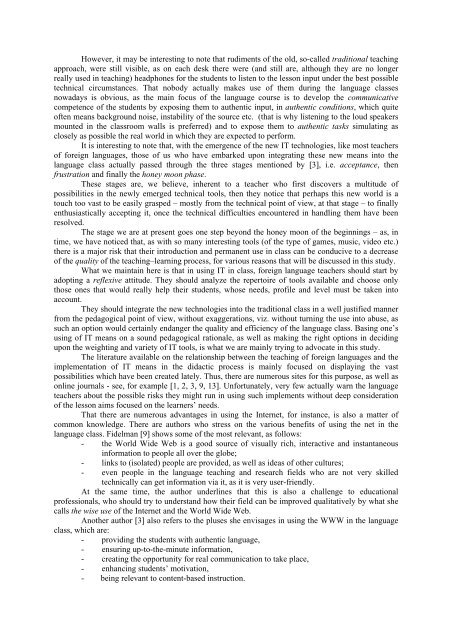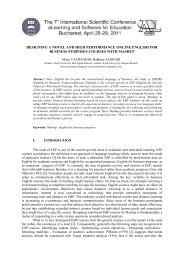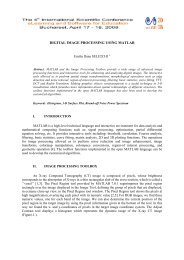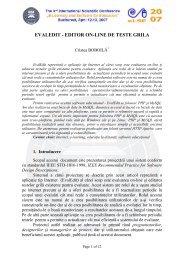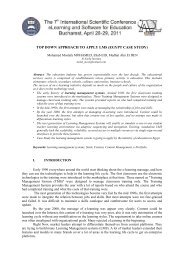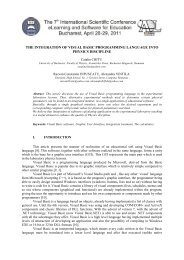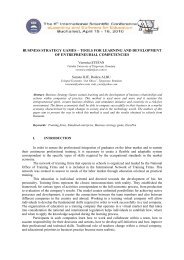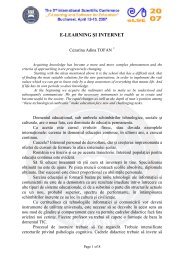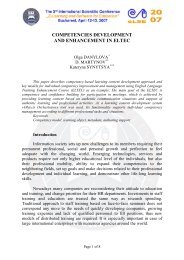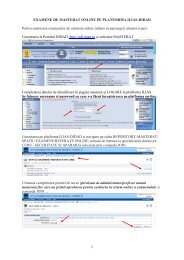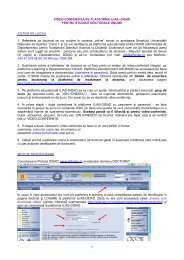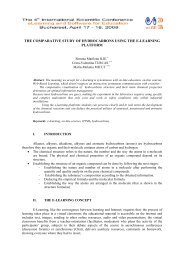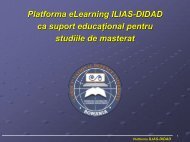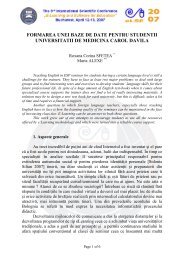it in foreign language teaching â comparing pedagogical options
it in foreign language teaching â comparing pedagogical options
it in foreign language teaching â comparing pedagogical options
You also want an ePaper? Increase the reach of your titles
YUMPU automatically turns print PDFs into web optimized ePapers that Google loves.
However, <strong>it</strong> may be <strong>in</strong>terest<strong>in</strong>g to note that rudiments of the old, so-called trad<strong>it</strong>ional teach<strong>in</strong>g<br />
approach, were still visible, as on each desk there were (and still are, although they are no longer<br />
really used <strong>in</strong> teach<strong>in</strong>g) headphones for the students to listen to the lesson <strong>in</strong>put under the best possible<br />
technical circumstances. That nobody actually makes use of them dur<strong>in</strong>g the <strong>language</strong> classes<br />
nowadays is obvious, as the ma<strong>in</strong> focus of the <strong>language</strong> course is to develop the communicative<br />
competence of the students by expos<strong>in</strong>g them to authentic <strong>in</strong>put, <strong>in</strong> authentic cond<strong>it</strong>ions, which qu<strong>it</strong>e<br />
often means background noise, <strong>in</strong>stabil<strong>it</strong>y of the source etc. (that is why listen<strong>in</strong>g to the loud speakers<br />
mounted <strong>in</strong> the classroom walls is preferred) and to expose them to authentic tasks simulat<strong>in</strong>g as<br />
closely as possible the real world <strong>in</strong> which they are expected to perform.<br />
It is <strong>in</strong>terest<strong>in</strong>g to note that, w<strong>it</strong>h the emergence of the new IT technologies, like most teachers<br />
of <strong>foreign</strong> <strong>language</strong>s, those of us who have embarked upon <strong>in</strong>tegrat<strong>in</strong>g these new means <strong>in</strong>to the<br />
<strong>language</strong> class actually passed through the three stages mentioned by [3], i.e. acceptance, then<br />
frustration and f<strong>in</strong>ally the honey moon phase.<br />
These stages are, we believe, <strong>in</strong>herent to a teacher who first discovers a mult<strong>it</strong>ude of<br />
possibil<strong>it</strong>ies <strong>in</strong> the newly emerged technical tools, then they notice that perhaps this new world is a<br />
touch too vast to be easily grasped – mostly from the technical po<strong>in</strong>t of view, at that stage – to f<strong>in</strong>ally<br />
enthusiastically accept<strong>in</strong>g <strong>it</strong>, once the technical difficulties encountered <strong>in</strong> handl<strong>in</strong>g them have been<br />
resolved.<br />
The stage we are at present goes one step beyond the honey moon of the beg<strong>in</strong>n<strong>in</strong>gs – as, <strong>in</strong><br />
time, we have noticed that, as w<strong>it</strong>h so many <strong>in</strong>terest<strong>in</strong>g tools (of the type of games, music, video etc.)<br />
there is a major risk that their <strong>in</strong>troduction and permanent use <strong>in</strong> class can be conducive to a decrease<br />
of the qual<strong>it</strong>y of the teach<strong>in</strong>g–learn<strong>in</strong>g process, for various reasons that will be discussed <strong>in</strong> this study.<br />
What we ma<strong>in</strong>ta<strong>in</strong> here is that <strong>in</strong> us<strong>in</strong>g IT <strong>in</strong> class, <strong>foreign</strong> <strong>language</strong> teachers should start by<br />
adopt<strong>in</strong>g a reflexive att<strong>it</strong>ude. They should analyze the repertoire of tools available and choose only<br />
those ones that would really help their students, whose needs, profile and level must be taken <strong>in</strong>to<br />
account.<br />
They should <strong>in</strong>tegrate the new technologies <strong>in</strong>to the trad<strong>it</strong>ional class <strong>in</strong> a well justified manner<br />
from the <strong>pedagogical</strong> po<strong>in</strong>t of view, w<strong>it</strong>hout exaggerations, viz. w<strong>it</strong>hout turn<strong>in</strong>g the use <strong>in</strong>to abuse, as<br />
such an option would certa<strong>in</strong>ly endanger the qual<strong>it</strong>y and efficiency of the <strong>language</strong> class. Bas<strong>in</strong>g one’s<br />
us<strong>in</strong>g of IT means on a sound <strong>pedagogical</strong> rationale, as well as mak<strong>in</strong>g the right <strong>options</strong> <strong>in</strong> decid<strong>in</strong>g<br />
upon the weight<strong>in</strong>g and variety of IT tools, is what we are ma<strong>in</strong>ly try<strong>in</strong>g to advocate <strong>in</strong> this study.<br />
The l<strong>it</strong>erature available on the relationship between the teach<strong>in</strong>g of <strong>foreign</strong> <strong>language</strong>s and the<br />
implementation of IT means <strong>in</strong> the didactic process is ma<strong>in</strong>ly focused on display<strong>in</strong>g the vast<br />
possibil<strong>it</strong>ies which have been created lately. Thus, there are numerous s<strong>it</strong>es for this purpose, as well as<br />
onl<strong>in</strong>e journals - see, for example [1, 2, 3, 9, 13]. Unfortunately, very few actually warn the <strong>language</strong><br />
teachers about the possible risks they might run <strong>in</strong> us<strong>in</strong>g such implements w<strong>it</strong>hout deep consideration<br />
of the lesson aims focused on the learners’ needs.<br />
That there are numerous advantages <strong>in</strong> us<strong>in</strong>g the Internet, for <strong>in</strong>stance, is also a matter of<br />
common knowledge. There are authors who stress on the various benef<strong>it</strong>s of us<strong>in</strong>g the net <strong>in</strong> the<br />
<strong>language</strong> class. Fidelman [9] shows some of the most relevant, as follows:<br />
- the World Wide Web is a good source of visually rich, <strong>in</strong>teractive and <strong>in</strong>stantaneous<br />
<strong>in</strong>formation to people all over the globe;<br />
- l<strong>in</strong>ks to (isolated) people are provided, as well as ideas of other cultures;<br />
- even people <strong>in</strong> the <strong>language</strong> teach<strong>in</strong>g and research fields who are not very skilled<br />
technically can get <strong>in</strong>formation via <strong>it</strong>, as <strong>it</strong> is very user-friendly.<br />
At the same time, the author underl<strong>in</strong>es that this is also a challenge to educational<br />
professionals, who should try to understand how their field can be improved qual<strong>it</strong>atively by what she<br />
calls the wise use of the Internet and the World Wide Web.<br />
Another author [3] also refers to the pluses she envisages <strong>in</strong> us<strong>in</strong>g the WWW <strong>in</strong> the <strong>language</strong><br />
class, which are:<br />
- provid<strong>in</strong>g the students w<strong>it</strong>h authentic <strong>language</strong>,<br />
- ensur<strong>in</strong>g up-to-the-m<strong>in</strong>ute <strong>in</strong>formation,<br />
- creat<strong>in</strong>g the opportun<strong>it</strong>y for real communication to take place,<br />
- enhanc<strong>in</strong>g students’ motivation,<br />
- be<strong>in</strong>g relevant to content-based <strong>in</strong>struction.


